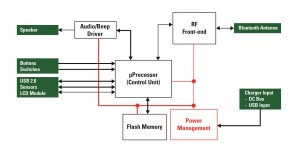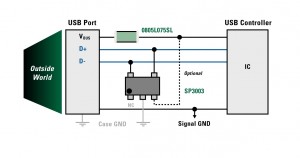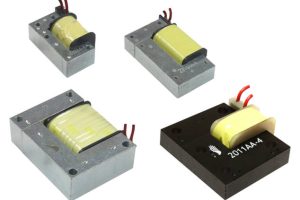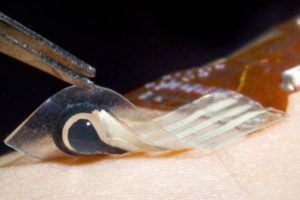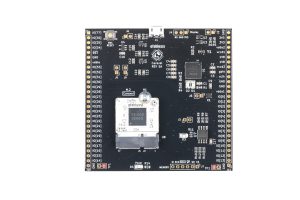A growing array of electronic devices is available to healthcare providers, patients, and their families, including glucose meters, blood pressure monitors, automated external defibrillators (AEDs), and many others. But even a seemingly minor electrostatic discharge could easily render a portable medical device useless.
To ensure safe, reliable performance of these devices, their designers should factor in circuit protection requirements from the earliest stages of the circuit design process.
Multiple aspects of a medical instrument’s circuitry are subject to a variety of electrical threats over its lifetime.
In short, any power or communication interface represents a potential gateway for an electrical transient and is also susceptible to damage over the lifetime of the device. In order to help ensure the reliable performance of the equipment, it is essential for circuit designers to pay attention to the power supply (battery pack, DC input, AC input), microprocessor, audio/speaker lines, communication interfaces (wired and wireless), sensors, LCD displays, keypads, and buttons.
Therefore, it is strongly recommended that they weigh circuit protection options as early as possible in the board layout process. Designers have to choose both the optimal protection device and the optimal location for use with a particular chipset.
In order to help ensure product safety and reliability, in the European Union, the Medical Devices Directives and Regulations has been implemented.
Specific to circuit protection, this document refers to clauses from EN60601-1-2 to provide guidance on EMC compliance for Medical Devices. These include references to EN 61000-4-2 (Electrostatic Discharge), EN 61000-4-4 (Electrical Fast Transients, Bursts), and EN 61000-4-5 (Transient Voltage Surges).
The objective for requiring these tests is to ensure that the applications will not fail due to electrical transients on the power line, nor suffer upset or damage due to electrostatic discharges that enter through the data and I/O lines.
Figure 1 is a simplified electrical diagram representing a handheld medical device (e.g. blood glucose meter, heart rate monitor) with the green boxes indicating circuits that may be susceptible to overvoltage or overcurrent conditions.
Because both patients and healthcare providers will handle this device frequently, the primary electrical threat is a simple static discharge. An electrostatic discharge (ESD) event can transfer excessive voltage and current to internal circuitry.
Fortunately, a variety of circuit protection devices are available to address overvoltage (ESD and lightning surge) and overcurrent (short circuits and overloads) situations.
For example, adding resettable positive temperature coefficient (PTC) thermistors to the USB port typically used to charge the batteries of portable instruments is one way to add overload current protection to portable equipment. These devices can limit current when an overload occurs, then reset to a low resistance value when the overload condition has passed, eliminating the inconvenience of having to replace a fuse.
For overvoltage protection, portable medical devices aren’t directly connected to the AC grid even during recharging, so they will be most likely to experience low level (remnant) surge events and ESD strikes. This limits the choices and simplifies the selection process. To protect against these events, space-efficient semiconductor-based devices can be used. The most common choices include TVS diodes and silicon protection arrays. These discrete diodes provide low clamping voltage performance to protect modern chipsets, which are often easily damaged.
To ensure the security and integrity of patient data, protecting the communication interfaces of medical devices is a high priority.
The Continua Health Alliance’s Design Guidelines define specific versions of Bluetooth and USB interfaces that act as wireless and wired transports to link health care instruments with caregivers. The following examples illustrate how various protection devices might be applied for portable equipment.
A handheld instrument’s wireless (RF) interface can be exposed to ESD surges induced through its antenna. This circuit shows a semiconductor-based solution that protects the RF amplifier input module of the Bluetooth circuit from ESD threats. The protection device is a 0.5pF (to maintain signal integrity) discrete diode that provides low clamping voltage to protect the equipment’s sensitive RF front-end.
An instrument’s sensor input (such as the input that connects a test strip for a glucose meter to its controller IC) is the interface between the user and the measurement circuitry. This input also makes an instrument susceptible to ESD damage because the sensor makes contact with the user in some fashion. As shown in Figure 2 (bottom), several discrete diodes can be used in this circuit (four lines are shown here). These devices offer low clamping voltage, as well as extremely low leakage current (< 100nA) and can ensure the sensor circuit receives a strong enough signal to produce an accurate measurement.
Figure 1 offers an example of how to combine technologies to provide a more complete circuit protection solution for the legacy USB 2.0 port. First, a resettable PTC is used to protect against overcurrent conditions, in this case, a very low resistance device in a compact 0805 surface-mount package.
This characteristic ensures that power dissipation and voltage drop are minimised when the device is being charged.
Second, the power port and the I/O lines should be protected against ESD. This figure illustrates an array that protects all three lines and has a capacitance value low enough to ensure there is no data loss during high-speed (480Mbit/s) data transmission.
During regular use of a medical device, users make contact with the on/off switch and various other buttons frequently. Space-efficient diodes in a 0201 package can protect these controls.
These diodes can be extremely robust against ESD (up to 30kV contact discharge) and their small form factor allows them to be easily incorporated into the circuit board design. The discrete form factor also offers the board designer high layout flexibility.
The previous circuit protection examples highlighted some considerations for portable medical equipment. For higher-end equipment (imaging, diagnostic, lab), additional protection devices are relevant because this equipment is much more complicated and is exposed to a greater number of electrical threats.
James Colby is manager for business and technology development for the semiconductor business at Littelfuse.
 Electronics Weekly Electronics Design & Components Tech News
Electronics Weekly Electronics Design & Components Tech News
